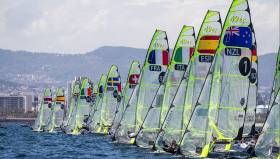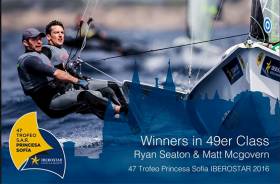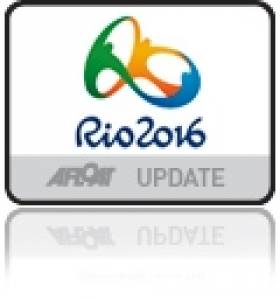Displaying items by tag: Matt McGovern
Disappointment for Irish 49er in Euros Silver Fleet
A lack of consistency has put this month's gold medal winners of the Trofeo Princesa Sofia regatta into the Silver fleet of the 49er European Championships in Barcelona this morning. Belfast's Ryan Seaton and Matt McGovern say they 'struggled to get off the start line' during qualifiers this week even though they opened the regatta on Monday in top form (6 and 2). Since then conditions have been 'difficult'. A start line penalty (UFD) on the first day did not help matters for the Ballyholme Yacht Club pair.
Yesterday was a stressful final day of qualifying for the 72–boat 49er fleet, only 25 of whom made gold fleet. With seven of ten scheduled races completed there were still more than 20 teams on the bubble hoping to sail well enough to keep their hopes alive. The conditions were a combination of side shore and off shore breeze, which gave fits to the race officers and sailors alike to find suitable racing conditions. After the 9th race of the qualifying bubble had shrunk from about 20 teams to 8, only separated by six points with half going to make the gold fleet and half stuck on the outside looking in. The Irish Rio hopes ended up 14 places outside the cut for gold in 39th place. The results are here.
The untouchable Kiwis Peter Burling and Blair Tuke extended their lead on the day with two more race wins in the 49er
Gold Fleets Next
Gold fleet will race for the final three days, 25 boats in 49er, 36 boats in the 49erFX. The 49er Silver fleet will be split into two equal fleets who will continue to race on an equal footing for places 26 through 72.
Ireland's Andrea Brewster and Saskia Tidey from Dun Laoghaire are lying 21st in the FX division.
Both the Irish 49er and 49erfx are qualified for Rio.
Only a week after a spectacular gold medal in Palma, Belfast Lough's Ryan Seaton and Matt McGovern are back in action this morning at the 49er European Championships in Barcelona.
Qualifying rounds start today until Wednesday with the finals from April 14-17. It would be an impressive performance for Team Ireland if the skiff pair could keep the momentum going in their Rio campaign.
After some earlier disappointing performances by their own accuont, last week's medal now raises the prospect of a strong Olympic Skiff result in four months time. Rio will be the second Olympics for the Northern Ireland duo and the dream of a top ten place in the mens 49er comes with it.
Last week's Mediterranean gold is an endorsement of the progress the Ballyholme Yacht Club pair have made, especially beating 2012 Olympic Champions Nathan Outteridge and Iain Jensen of Australia.
The joint-funded Irish Sailing Association (ISA) and Royal Yachting Association Northern Ireland team were 14th at the last Olympics and have had brief spots near the top of the fleet, including silver at the Sailing World Cup Hyeres Regatta in 2014, but last week they showed the depth of their ambition when they stepped to the top of the podium. Helmsman Seaton concluded: 'To be so solid has been important. This was really a training regatta along the way, it's important but it is a great platform for us and the confidence it brings, winning a big regatta at this stage, is immense.'
It is a major boost and Seaton is wise to put the result in context. It was not a Sailing World Cup regatta, and, as such, these events are often used by top sailors to test gear and try new tactics. With big fleets in attendance, the Trofeo Princesa Sofia was a test bed opportunity and the Belfast crew took full advantage of it but Seaton knows the real test is the European Championships in Barcelona this morning, in what will be a deep fleet, they come face to face with Blair Tuke and Peter Burling, the Kiwi world champions who have won every regatta they have entered this quadrennial.
Also racing in Barcelona this week is the Rio qualified skiff of Andrea Brewster and Saskia Tidey.
Belfast Lough's Seaton & McGovern Stay on Course at 49er Worlds
Olympic sailors Ryan Seaton and Matt McGovern continue to stay very much on target at the 49er Worlds in America this week, surviving a very light day three of the championships in Clearwater, Florida. Yesterday, kicked off with a sunny, 4-8 knot variance giving everyone a sigh of relief and readiness. The Belfast duo are now 13th overall counting an 8, 26.0 2, 6.0 14.0.
The fleet rigged up and got after it early launching to make a 10am start. The breeze dropped quite a bit, but after one general recall, the fleets were able to begin their day. One race was sailed in a slowly dying 5-7 knots, but unfortunately a third of the fleets were DNF due to the almost non-existent pressure. Almost two hours later and the 49er gods finally answered the RC's prayers. A building sea breeze allowed the boys to sail three more races getting a total of four in before the ladies were sent out to reap the same wind benefits.
Irish Olympic Sailing Team Racing in Miami, Second Round of Women's Laser Trial Underway
A mixed Irish sailing team of youth and experience compete in Miami this morning at the start of Olympic year that includes, as previously reported on Afloat.ie, the second round of the women's Irish Laser Radial trial between Annalise Murphy and Aoife Hopkins.
Already qualified for Rio, Ryan Seaton and Matt McGovern are racing in the 49er as is the three-man Paralympic Sonar sailing team of John Twomey, Ian Costello and Austin O’Carroll. Still seeking an Olympic nomination are hopefuls Andrea Brewster and Saskia Tidey in the 49erFX class.
In less than 200 days, many of the nearly 800 sailors gathered in Coconut Grove this week will walk in the Opening Ceremonies of the 2016 Rio Olympic Games and the Paralympic Games. For the sailors with a confirmed spot in the Olympic Regatta, this event is about sharpening their tactical game, refining their equipment and improving their conditioning. Others have a more immediate focus as they are in the midst of a selection series for their respective countries or working to qualify their country for the Olympic regatta.
Team Seaton-McGovern will be looking to take last season’s ups and downs into what is a tough regatta, and with stiff competition from the world’s best skiff crews, the pressure is on. In the 49erFX boat, Team Brewster-Tidey will be looking to build on last year’s performances in preparation for a final qualification bid.
“There’s a lot at stake this year at Sailing World Cup Miami,” said Josh Adams, Managing Director of U.S. Olympic Sailing. “For the first time in the event’s 27-year history, it’s being used as part of the U.S. selection process and part of country qualification process for the 2016 Olympic Games.”
For American sailors in eight of the Olympic classes and the 2.4mR, this event is the first of two events that will determine the U.S. Olympic Sailing Team for this summer’s Games.
Sailing World Cup Miami is the second of six regattas in the 2016 series. From 25-30 January 2016, Coconut Grove, Miami, USA is hosting more than 780 sailors who are competing across the ten Olympic and two Paralympic classes on the beautiful waters of Biscayne Bay.
Sailing World Cup Miami is the second of six regattas in the 2016 series. From January 25-30, 2016, Coconut Grove, Fla., is hosting more than 780 sailors from around the world who are competing across the ten Olympic and two Paralympic classes on the beautiful waters of Biscayne Bay.
Competition in US Sailing’s premiere racing event gets underway this Monday in all 10 Olympic classes and two of three Paralympic classes. Saturday’s Medal Races will be carried live on ESPN3.
The Olympic classes competing this week will be: Laser Radial (women), Laser (men), Finn (men), Men’s RS:X, Women’s RS:X, 49er (men), Men’s 470, Women’s 470, Nacra 17 (mixed) and 49erFX (women). Paralympic classes included are the 2.4mR (open, Para World Sailing) and Sonar (open, Para World Sailing).
Seaton & McGovern Finish 11th At 49er Euro Champs in Porto
#49er – New Zealanders Pete Burling and Blair Tuke have won the 49er European Championships, after dominating the final day of competition on the huge Atlantic swell off the coast of Portugal. Ireland's Ryan Seaton and Matt McGovern finished 11th making steady progress up the fleet from an opening result in the 30s.
The Kiwis went into the day in 3rd overall, after coming off worse from a protest by Nathan Outteridge and Iain Jensen the previous evening. The Aussies were sailing upwind out of the leeward gate when the Kiwis, below the layline as they were dropping their gennaker, fouled the 2012 Olympic Champions. The Kiwis' subsequent disqualification dropped them to 3rd overall, 7 points behind the Aussies who assumed the championship lead.
The surprise silver medallists were Germany's Justus Schmidt and Max Boehme who have had a meteoric rise up the rankings this season. The up-and-coming young team won Kiel Week a few weeks earlier, and now with a 2nd place in Porto they hold a useful points lead in the German trials for Olympic selection for Rio 2016. This was the first of three regattas that the Germans are using for their trials process.
The bronze medal went to John Pink and Stu Bithell who bounced back from their disqualification last night with a great performance on the water, edging Outteridge and Jensen off the podium by just 2 points.
Today's victory marks an unbroken run of 18 regatta wins for Burling and Tuke who have been invincible since taking the Olympic silver medal at London 2012 behind arch-rivals Outteridge and Jensen.
Final top five:
1. Peter Burling / Blair Tuke, NZL, 32 points
2. Justus Schmidt / Max Boehme, GER, 44
3. John Pink / Stuart Bithell, GBR, 46
4. Nathan Outteridge / Iain Jensen, AUS, 46
5. Lukasz Przybytek / Pawel Kolodzinski, POL, 35
Results downloadable below
Irish Olympic 49er Pair Continue Climb Up Euro Leaderboard
#49er – Belfast duo Ryan Seaton and Matt McGovern continue to climb back up the leaderboard of the 49er European Championships in Portugal. Very light airs made for a tricky fourth day at the 49er and 49er FX regatta in Porto. After a long wait ashore for the breeze to fill in, the 49erFX sailors were sent home without any gold fleet finals racing today. By late afternoon a light breeze was blowing out to sea, and the 79-boat 49er men's fleet went out for two tricky races to complete their qualifying regatta before the gold fleet split.
Seaton and McGovern are now in 13th place having scored another nine and a three yesterday evening to move up from 18th overall. By contrast, the reigning Olympic Champions, Nathan Outteridge and Iain Jensen, suffered in the fickle conditions, falling from 3rd to 11th overall after scoring 13,22. Their big rivals, the reigning World Champions from New Zealand, keep on chipping away with some solid results.
Qualifying is now complete for both the men's and women's fleets, so Friday sees the start of Gold Fleet finals. The forecast is for better breeze, and you can watch all the action on the live TV broadcast which is scheduled for the start of racing this morning at 1030am local time HERE.
Top five
1. Jorge Lima / Jose Costa, POR, 24 points
2. Peter Burling Blair Tuke, NZL, 32
3. Lukasz Przybytek / Pawel Kolodzinski, POL, 35
4. Dylan Fletcher Scott / Alain Sign, GBR, 38
5. Jonas Warrer / Anders Thomsen, DEN, 39
Full results downloadable below.
Seaton & McGovern Start Euro 49er Champs in Porto
#49er – Belfast lough's Ryan Seaton and Matt McGovern are lying 30th at the 49er European Championships in Porto, the second city of Portugal. After four races sailed the Rio qualified pair's top result was a fourth in today's second race. Download results below. Results in this regatta are important for the Northern Ireland duo. Though they have already qualified for Rio, this event represents one of only three annual opportunities to meet Irish Sports Council funding criteria. The sole Irish pair will need a top three finish to move up a financial bracket.
A port tack flyer launched the Portuguese into the lead in Porto. Jorge Lima and José Costa have claimed an early lead in the 49er European Championships on home waters in Porto, the second city of Portugal. With the 79-boat fleet split into three qualifying divisions for the first three days of competition, the inshore course favoured the right-hand side strongly throughout the day, especially so in light airs that never exceeded 8 knots.
While most of their competitors were battling for a start line advantage at the right-hand end near the committee boat, Lima and Costa decided to take their chances with a port-end start. It paid off handsomely, with the Cascais team taking an early lead in both of the last two races of the day, and leading both heats from start to finish. Banking scores of 2,6,1,1, the Portuguese hold a 1-point advantage over Poland's Lukasz Przybytek and Pawel Kolodzinski, who also sailed a brilliant day in their qualifying fleet with scores of 1,2,4,2.
Asked what was their secret today, Lima replied: "Local support, from our sponsors, our families and friends. We are from the South, these are not our local waters and we haven't done that much training here. But it's good to be in our home country with the support of our own people, and that makes a difference." Lima and Costa wear the yellow Seiko rash vests for day 2, but with a total of 20 scheduled races and just four completed, they know it's far too early to be counting their chickens. "It's a good position to be in, but we have to perform every day if we have a chance of winning these Championships."
For the Poles, lying in 2nd overall is particularly important as this regatta is one of the trials for Olympic selection for Rio 2016. The same is true for the Germans, and it's been a disappointing start for the defending European Champions, Erik Heil and Thomas Ploessel who lie in 35th overall. Worryingly for them is that recent winners of Kiel Week, young guns Justus Schmidt and Max Boehme, are sitting in 4th place overall with scores of 6,1,1,7.
Other good performers on day one were British team, John Pink and Stu Bithell, in 3rd overall, and the 2012 Olympic Champions from Australia in 5th, Nathan Outteridge and Iain Jensen. Not such a good day for the 2012 silver medallists from New Zealand however, with Pete Burling and Blair Tuke sitting in 8th overall. A 4,6,2 wasn't too bad, but a UFD disqualification in heat three was the Kiwis' undoing. "The start hooter came up a bit later than we expected," shrugged Burling. "We knew it was close. Speed was OK though, just a couple of decisions we made that could have been better." Even after an average first day, the Kiwis remain the hot favourites for overall victory, now on an unbroken winning streak of 16 major regattas since London 2012.
Medal Race Finish Gives Ryan Seaton & Matt McGovern Eighth Overall in Santander
#santander2014 – Ireland's only medal race crew took ninth in this afternoon's light and shifty 49er medal race at the ISAF World Championships in Santander, northern Spain.The result gives Belfast's Ryan Seaton and Matt McGovern eighth overall in the high speed skiff class and, more importantly, country qualification for the Rio Olympics in 2016.
The result is the third country qualification for Ireland at the ISAF World championships, an event that was plagued by light winds.
The Medal Race was just like the regatta, dominated by New Zealand. Peter Burling and Blair Tuke (NZL) had an insurmountable lead going into the final. They had a middling first beat, but then made their move with a gybeset on the first run. They got into the lead by the bottom marks and never looked back, taking a huge win in the Medal Race to cap their huge win in the regatta. The duo are winning regattas and races by margins never seen before in the 49er, and look unstoppable. Time will tell whether they can hold this kind of form all the way through to Rio.
The real fight in the Medal Race was for the silver medal in the battle of Olympic gold medallists. Jonas Warrer, the Beijing 2008 Gold medalist with Anders Thomsen (DEN) were only two points off the London 2012 Gold medallists, Nathan Outteridge & Iain Jensen (AUS).
Outteridge and Jensen got off to a good start and were third around the first top mark while the Danes were back in eighth. However, there were position changes on every leg of the race, and on the final upwind the Danes got past the Aussies to secure their silver medal, leaving the Aussies to settle for Bronze.
The crowds were so big that it was standing room only, and they reserved their biggest cheers for the Paz brothers from Spain, who get their highest ever worlds finish with a 10th place.
In a week of highs for Irish qualifications in Santander James Espey in the Laser Standard was the first to qualify. A total of 72 nations were in contention for the top 23 spots but Espey secured Ireland's first ticket to Rio with ease as 16th nation. He finished 37th overall from a fleet of 147 boats.
Annalise Murphy, who had a poor start to the regatta, made a comeback to win the country its second place - this time in the Laser Radial class. Murphy finished 20th overall from 120 boats and 16th nation. Only the top 19 nations from a total of 58 earned their right to compete in Brazil.
Narrowly missing out on qualification were Andrea Brewster & Saskia Tidey. Competing in the female 49erFX skiff, they wrapped up an intense event as 13th nation and just shy of the necessary top 10.
18–year–old Finn Lynch was also competing in Spain at his first Laser Standard World Championship and finished in 101st place finish from 147.
Ross Hamilton was competing in the Finn class and finished 64th from 78.
Ryan Seaton & Matt McGovern Are Rio Bound Making 49er Top 10 At ISAF Worlds
#Santander2014 - Ryan Seaton & Matt McGovern are the third and fourth Irish sailors to clinch their spots for Rio 2016 on Day 8 of the ISAF Worlds in Santander, joining James Espey and Annalise Murphy among those already bound for Brazil.
Despite still having one more race to go tomorrow (20 September) in the 80-boat 49er class, the Northern Irish pair have built enough of a points gap to secure a coveted top 10 nation place in the 49er class.
Only 10 places are up for grabs in Santander by the top nations from a competing pool of 33. But the Northern Irish pair, who previously sailed at London 2012, knew that to qualify for Rio at this early stage would significantly ease the pressure.
Upon hearing the news, Seaton said: “Getting the qualification for Rio is a big boost for us. It’s one box ticked but we still have a job to finish. We’re here to get a medal so we’ve still got to keep pushing hard."
McGovern added: “Now we can focus on events in Rio rather than having to compete in Europe at the other qualifiers. From a preparation point of view it makes things a lot smoother”.
Seaton and McGovern made waves when they began competing in Santander earlier this week, finishing second in their opening race and quickly stationing themselves at the top of the leaderboard.
After the initial two days of the qualifying series, the pair qualified with ease for the Gold Fleet. From there they have remained in sixth place overall and sixth nation.
After two races today it was confirmed that they had enough of a points lead to have earned Ireland yet another Olympic place. They will have one final Gold Fleet race tomorrow before the top 10 boats progress to Sunday’s medal races, where they’ll battle it out for the 49er world title.
Meanwhile, in today's 49erFX Gold Fleet, Andrea Brewster and Saskia Tidey had a physically and mentally gruelling four races. The pair capsized in the first race and were unable to finish. Things did not improve too much with a 25, 19 and 20.
However, they will have one final shot at Olympic qualification tomorrow where they must be among the top 10 nations. The pair are currently 14th nation.
#irishsailing – After five years of economic contraction, there are signs of recovery, and the 2014 Irish sailing season has also got off to a flying start. W M Nixon looks at various signs of new energy and initiatives, and sees how they might be affecting stories which have been run on this blog and in the Afloat.ie website during the past year. But he concedes that further cost reductions will be necessary for the good of the sport.
A year ago, any talk of green shoots in Ireland was almost entirely metaphorical. And it was in the economic sphere, though even there they were still few and far between, with many soon stunted. But out in the farmers' fields themselves, out where the grass should have been growing, there was scarcely a sign of life as we were still trapped in the coldest and most miserable Spring in living memory, and all forms of growth and recovery were blighted by it.
Sailing and boating, of all sports, are the most affected by Ireland's climatic conditions. Not only is the mood among participants strongly influenced by weather which sometimes can get anyone down, but without reasonable breezes, sailing events are seriously impaired. "We got a result!" may well be the PRO's final desperate claim after pulling some sort of a points table and leaderboard out of a series bedevilled either by too much or too little wind. But it's so much better to have a series bathed in sunshine and blessed by fine breezes, with enough races sailed for the crews to go home tired but happy without needing recourse to any of those weasel words which show you're only trying to justify a weekend of frustration.
Things could not be more different this year. The Spring of 2014 has been perfection, boats are going afloat on time and in reasonable weather conditions, and the first little crop of events and results are very encouraging indeed - so encouraging, in fact, that "little crop" doesn't do them justice.
That said, two of the nearer events which gave special cause for Irish celebration did not have perfect weather throughout. The Youth Sailing Nationals at Howth may have ended on a high with a great breeze in an early taste of summer sunshine, but one day out of the four was lost to bad weather. But the sting of that was lessened by the decision for "no racing all day" being taken at 1100hrs, which allows other leisure options to kick in.
The IRC Easter Championship in the Solent concluded through Easter Monday literally with "Darkness at Noon" – the heavy clouds and torrential rain on an almost windless day saw the final races being sailed with nav lights on. But there had been excellent racing on earlier days, and a very excellent result with Anthony O'Leary's Ker 39 Antix from Cork the clear supreme champion.
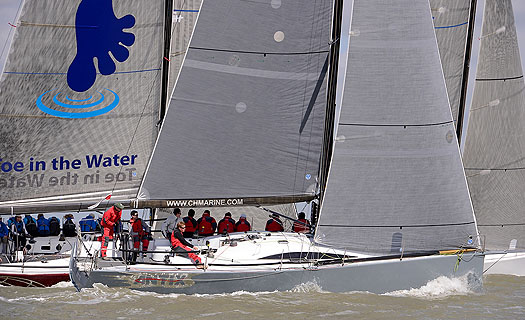
Doing the business. Anthony O'Leary's Ker 39 Antix settling into the groove on the way to the top place in the Easter IRC Championship. Photo: Rick Tomlinson
That in turn augured well for Ireland's Commodore's Cup chances, which then received a further boost last weekend when the crew of another Irish team wannabe, Quokka with Michael Boyd and Niall Dowling, had a winning weekend in the Warsash series with their temporary mount Tarka in anticipation of Quokka's return from the Caribbean at the end of May.

The Colours Match team racing between UCD and Trinity served up top sport in the Liffey, with Trinity winning. Photo: W M Nixon
Meanwhile the universities racing has been brought to life, for although UCD had a convincing win in the racing with the SailFleet J/80s to become the Irish team for the Student Yachting Worlds in France in the Autumn, before April was out the Colours Match in the Liffey under the burgee of the Royal Alfed YC, team-raced in Fireflies, saw Trinity take the honours in convincing style.
But if we're looking for something which really did set things freshly alight, it was out in Hyeres where the ISAF Championship saw the northern duo of Ryan Seaton & Matt McGovern take silver in the 49er, almost immediately moving them up the global rankings from 33 to 11, a quantum leap and no mistake.
The potential for serious success by these two has been fairly obvious for some time, but anyone who sails boats will know only too well how many factors have to come into alignment to get you up among the magic metals at the end of the day.

Stars of the silver sea – the Seaton/McGovern team took a silver medal for Ireland at Hyeres.
That their new global status was almost immediately acknowledged by this rankings improvement will in turn add heft to everything they do and say. Thus when, some time ago, the Ryan/Seaton equipe suggested that the 2016 Olympics sailing waters in Brazil are so off the standard as to be a health hazard, it attracted polite attention. But now that they're Number 11, and still counting down, much more notice is taken. And the fact that the Vice President of the International Olympic Committee has suggested, with something approaching despair, that the facilities in Brazil just aren't going to be ready for 2016 at any standard, all gives added legs to the statement from Ireland's 49er crew.
This in turn makes us wonder where world sailing might go in 2016 if the Brazilian setup is still Work in Progress. With tongue only slightly in cheek, we suggest they need look no further than West Cork, where Baltimore Sailing Club has been expanding its facilities to meet increased demand as a club which last year introduced something like 700 people to sailing. That BSC and current Mitsubishi Motors "Club of the Year" Kinsale YC further east along the West Cork coast have both been putting in premises up-grade during the past year, while other clubs have been having it tough, and just about hanging in there in some cases, surely gives pause for thought.
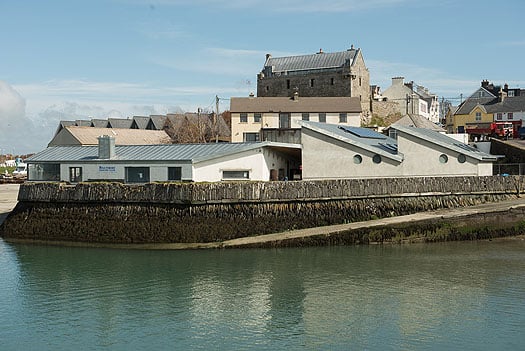
Olympic venue? The extended and up-graded Baltimore Sailing Club is ready and raring to go.
The economic shakeout of the past five years has caused a massive write-down in the value of almost all property and other assets. And in the case of yacht and sailing clubs, there has been a detailed examination of the continuing validity, or otherwise, of established yacht clubs and their traditional business model of quite high subscriptions under-writing other facilities which in turn combine to provide the complete package of an orthodox yacht club.
Inevitably, most clubs are run by officers and committee members who have been involved with the club for many years. Thus, like people who have been running a quality hotel for decades, they may have an inflated notion of what their organisation and its premises are actually worth. Admittedly there's only limited usefulness in comparing a yacht club with a hotel, but lessons can surely be learned. The fact is that hotels today are worth maybe only a third or even less of what they were reckoned to be worth six years ago. And equally, while yachts clubs certainly have a unique package to offer, is it unusual enough and special enough to charge high subscriptions when there are alternative facilities and services available?
The dilemma arises to some extent in all sailing centres. Last week we were discussing the story of the development of Howth YC. Today it is in the seemingly happy situation of having its own marina, thus it theoretically can offer an attractive all-in-one package to any potential member. But the very fact that Howth YC has done so much to help make Howth a colourful and vibrant sailing/fishing port is partly to its own disadvantage. The place has developed as a remarkable focus for top seafood restaurants. This means that the extensive club catering facilities – expected by traditional members - are constantly battling for business with a whole slew of award-winning eateries and characterful pubs nearby.
The problem is more acute in Dun Laoghaire in that the only club within the marina area is the Royal Irish YC. Thus while people may have been loyal members of the National, the Royal St George and the Dun Laoghaire Motor Yacht Club, they find that after going out in the boat, it's very easy to round out the evening aboard in the marina, chatting among themselves or with other crews on boats nearby, and then head straight for home without making their number in their home clubs at all.
This situation is less in evidence at weekends and during special events. But nevertheless it was causing such a lessening in mid-week club vitality that various steps have been taken, and the Royal St George's move to take over berths in a block booking in the outer marina, and service them by a frequent ferry direct from the clubhouse, is a visionary step.
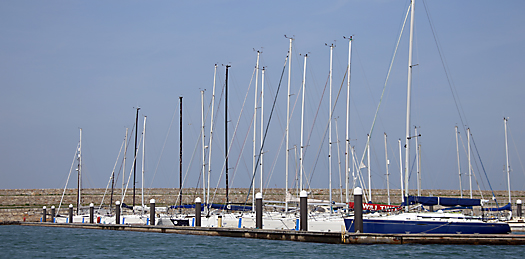
The Royal St George YC has introduced a direct ferry service from the clubhouse to its group of berths in the outer marina in Dun Laoghaire. Photo: David O'Brien
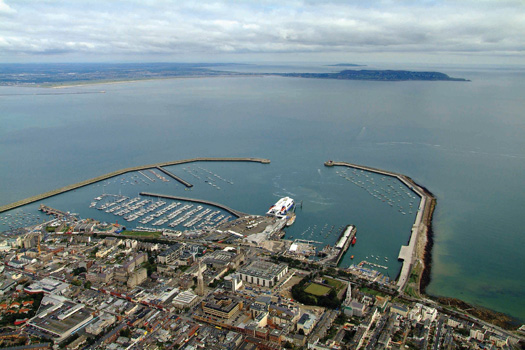
To overcome a lack of direct access to the Dun Laoghaire Marina, the Royal St George YC is running a ferry service from its clubhouse (to right of Stena Ferry, foreground) to the berths in the Outer Marina (upper left) Photo Kevin Dwyer/courtesy ICC.
Nevertheless, in all club administrations there are those who are of the opinion that, whatever the Honorary Treasurers may believe, there has to be a radical re-think of the primary subscription levels. In essence, they're suggesting that the book value of the club has to be written down such that subscriptions are halved. Personally, I haven't much of a notion of how to read a balance sheet, but the dogs in the street know that in the hospitality industry – which, in the broadest sense, is the area in which yacht and sailing clubs operate – values have been savagely slashed, and while charges may still seem high, at least the places are surviving as going concerns.
With continuing reduction in expenses across the board, one area in which there seems to be much work afoot is in the Irish Sailing Association, which in latter days had begun to seem like some hidden corner of the civil service, existing more for the benefit of staff than for the provision of services for sailors. It's amazing to learn that the ISA has sixteen fulltime staff, and a basic annual wages bill of something like €600,000. When you add in the expected benefits, it musty come in total to a very tidy yearly sum.
What on earth do they all do? While you'll invariably find the ISA logo in prominence at some top events, it has to be said that you're entirely unaware of the organisation's existence in any form at more everyday happenings, and it doesn't seem to be because they believe in doing good work by stealth. But with special study groups resulting from the major changes introduced in the ISA setup at the AGM in March, we can only hope that in time the Association will reflect the cost-cutting which has had to be introduced in the clubs, which provide the main part of the ISA's income.
While the administrative structures are rightfully being pared back in many areas of our sport, the coastal infrastructure, on which all forms of seagoing ultimately depend, continues to need maintenance and development. In this area, one very promising green shoot is the news that there are signs of movement in Dunmore East. A dredging programme is getting under way, and just this Tuesday, Minister for Marine Simon Coveney TD convened a meeting in the port to inaugurate a community approach to harbour development which, it is hoped, will help to invigorate the many places around Waterford Estuary, for which Dunmore East has the potential to be the true gateway harbour.

Dunmore East – can it fulfil its potential as the gateway leisure port for the Waterford Estuary? Photo Kevin Dwyer, courtesy ICC
In a more extreme marine environment, it has been confirmed that €6 million will be spent on improving the pier at Doolin in northwest Clare, the nearest mainland quay to the Aran Islands, which also caters for the tour boats cruising along the Cliffs of Moher. While the locals seem well pleased, I wouldn't get too excited about it. This is one very rugged part of the coast, and when you remember that it took €31 million to extend the pier at Kilronan in Inismor, the main Aran island, and another €14 million to build the little harbour at the north end of Inis Meain, the middle Aran island, then we can only hope that €6 million is going to achieve something more than a few boulders being shifted about in the roaring ocean at Doolin.

The pier at Doolin is decidedly minimalist, but it provides the shortest sea passage to the Aran Islands. Photo: W M Nixon
But then, in the west all things are possible, and along the ocean seaboard we're told that four thousand signs are being erected to guide people along the Wild Atlantic Way, the new tourism initiative using many smaller coastal roads. Quite so. Frankly, with signage at this level, it will be the Tame Atlantic Way by the time half of them are in place. I have to admit to being a complete curmudgeon in this. In many years of transitting Ireland's west coast by sea and land, one of our favourite areas while driving along the west coast has long been the coast south of Kilkee down to Loop Head, where the cliffs comfortably rival anything the vulgar Cliffs of Moher have to offer, and it is magnificently uncrowded. But not any more, if the Wild Atlantic Way movement has its way.
While I appreciate that visitor numbers have to be kept up and increased whenever and however, it has to be done in a way which appreciates that's what brings people to Ireland (rather than just to Dublin, which is a special case) is an unspoilt landscape. So, four thousand signs just for the one Atlantic Way? Ogden Nash had something to say about this:
"I think that I shall never see,
A billboard lovely as a tree.
But then, until the billboards fall,
I'll never see a tree at all".
Be that as it may, the final sign that suggests things are on the move again is a notice I spotted recently posted at a nearby club, though language pedants might wonder how a notice which manages to mangle so utterly the plural of "dinghy", even to adding a completely superfluous greengrocer's apostrophe, could be seen as encouraging in any way whatsoever.
Well, once you've overcome your opinions about the errors, the underlying message must be good news. More youngsters are evidently coming to sailing this year. And as for the spelling mistake, even that's an improvement. A year ago, the same notice board opened by referring to something called "a dingy", but this time round we have to get to the second line before finding that. And it all comes right for dinghies in the end.
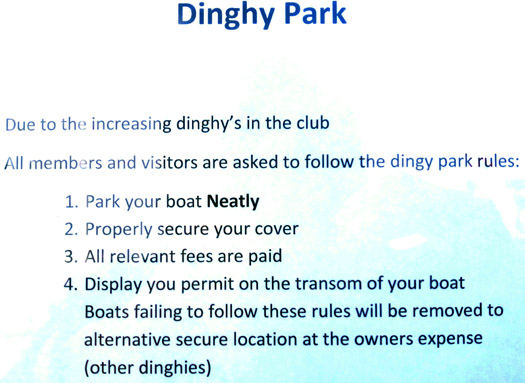
Sign of the times? Whatever about the spelling, this current notice at an Irish sailing club has an underlying message of good news. Photo: W M Nixon



























